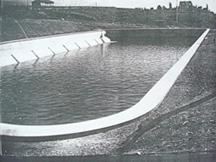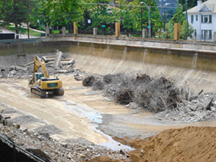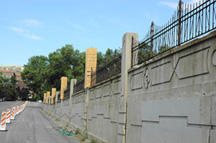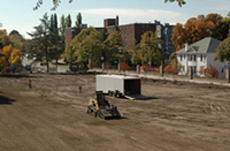Thirteenth East Reservoir – A Bit of History Disappears
This historic concrete structure is to be buried with only the 1300 East Street side-wall remaining.
LeRoy W. Hooton, Jr.
November 8, 2009
Looking south, the Thirteenth East Reservoir filled with water in 1900.

The Thirteenth East Reservoir was one of the earliest reservoirs constructed for the purpose of delivering municipal drinking water supply to the inhabitants of Salt Lake City. It was the first reservoir located outside of City Creek Canyon; and when it was constructed it was the largest with a capacity of 5-million gallons.
The reservoir was constructed in 1900. In the beginning, it was supplied water from Emigration Creek through a 12-inch pipe originating 3 miles away at the outlet of Emigration Canyon. Shortly thereafter, Parley's Creek water was conveyed to the reservoir via the 36-inch Parley's Lower Conduit, which was built in 1892 with a flow capacity of 23 million gallons per day. In 1905, Big Cottonwood Creek was added to the water supply when the 40 million gallons per day Big Cottonwood Conduit was constructed.
In the 1930s, as a drought relief project, a 1.2 cubic-foot-per-second well was drilled on the corner of 1300 East and South Temple Street. The well supply could be pumped directly into the distribution system or into the reservoir.
|
In 1914, the Thirteenth East Reservoir became a community landmark with its decorative concrete wall fronting 1300 East Street. In 1929, the reservoir site was integrated into Reservoir Park, making it a popular public gathering place. In 1956 another amenity was added when tennis courts were installed on the reservoir deck for public use.
As the City continued to grow in the early 1900s, it became more difficult to transport water that originated on the east side westward to the business district and west side of the city. In response to the limited distribution capacity, new pipe lines and reservoirs were constructed to improve the flow of water supplies. First, the 10-million gallon Fifteenth East Reservoir (1500 East 500 South) was constructed in 1915 to distribute water westward. In 1920, the Parley's high line conduit and 30-inch Sunnyside pressure line were completed, increasing the flow capacity by 40 million gallons per day. The Thirteenth East Reservoir was the terminus for water supplied from both the Parley's Lower Conduit and Sunnyside supply main.
In 1924, the Sunnyside Reservoir (located north of the present-day Baskin Reservoir) was constructed. It failed in 1926 and was abandoned and replaced in 1932 with the 9.74-million gallon Baskin Reservoir. Also, built in 1932 was the 10-million gallon Sam Park Reservoir at the mouth of Parley's Canyon, which supplied water to both the Parley's Lower Canal and Parley's high line conduit. In 1979, the 12-million gallon Military Reservoir further bolstered the distribution capacity on the city's east bench. Currently the City has 33 distribution reservoirs and tanks with a total capacity of 181.42 million gallons within its service area.
|
In 1945, additional distribution capacity was constructed to convey municipal water supply to the avenues and downtown areas. Four thousand feet of 20-inch main and 1,700 feet of 16-inch main were constructed between First South and approximately Wolcott Street to Wasatch Boulevard and “U” Street.
During this early era, raw water storage reservoirs enhanced the City's water supply. In 1892, the Parleys Canyon Reservoir at Suicide Rock was the first storage reservoir built with a capacity of 3.28 acre-feet. Later it was abandoned when in 1917 Mt. Dell Reservoir was constructed and then enlarged in 1925 to 3,100 acre-feet capacity. Two storage reservoirs were constructed in Big Cottonwood Canyon: Lake Mary and Twin Lakes Reservoirs were built in 1916-17 with 743 and 939 acre-feet of capacity respectively.
In 1957, the Thirteenth East Reservoir was covered with a concrete deck at a cost of $162,791. This was part of a program of covering all of the City's reservoirs and constructing water treatment plants, leading to EPA's fully certifying the City's water supply in 1976.
Large federal water projects have greatly enhanced the City's water supply. Beginning in 1952, the Metropolitan Water District of Salt Lake City first delivered water from the Provo River Project (Deer Creek Reservoir) into the City's east side distribution system from the Salt Lake Aqueduct and Terminal Reservoirs. Using these same conveyance system, later water from the Central Utah Project flowed to the City.
In the 1980s, Public Utilities' reconstructed and enlarged the capacity of two major conveyance facilities. In 1982, the Big Cottonwood Conduit (1905) was replaced with a larger capacity pipe; and in 1986, the Parley's Lower Conduit (1892) was replaced with the Terminal Park Reservoir Pipeline. These replacements provided additional water to the City's distribution system from the Cottonwoods, Deer Creek Reservoir and Jordanelle Reservoir.
In 1993, an engineering study found structural problems with the Thirteenth East Reservoir's deck, prompting the Department of Public Utilities to cordon off access to the tennis courts. Shortly thereafter, the reservoir was taken out of service. Over the subsequent years, various options were studied to determine the disposition of the structure.
|
This past year, the decision was made to abandon the reservoir by burying it and restoring the site with landscaping at a cost of $386,000. The reservoir was demolished by removing the deck, pillars and reinforcing bars, while preserving the 1300 East Street side wall and street lights. The reservoir hopper walls and floor were buried and the overlaying surface contoured to blend into the park landscape with grass and a new sprinkler system installed.
For over its 90 years of operation, the Thirteenth East Reservoir was a key component of the City's water system – especially during early years when it was the only large distribution reservoir located on the City's east side. With the demolition of this reservoir, one of the oldest reservoirs built by the City will disappear from the cityscape. However, the preservation of the outside decorative street wall will leave a lasting reminder of this historic structure.


